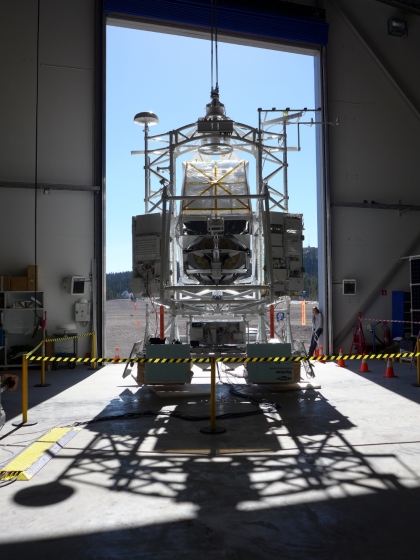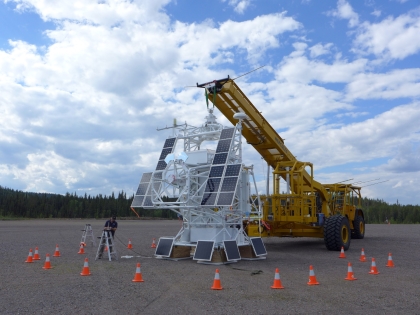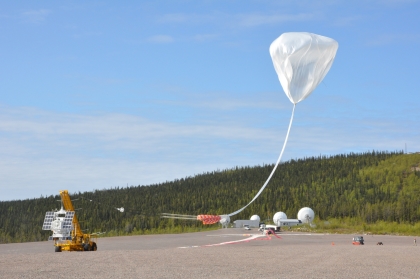Press Release 8/2013 - June 3, 2013
Sunrise 2: A journey to the active Sun
Four years after its first mission, the Sunrise team is preparing the balloon-borne solar observatory for a second flight. The launch is expected in the next days.
After two months of preparations in Kiruna in the north of Sweden, the balloon-borne solar observatory Sunrise is ready for its next flight: only a last ground-based rehearsal is still necessary. As soon as the weather conditions are right, a huge, helium-filled balloon will carry Sunrise to a travelling height of approximately 35 kilometers. Equipped with the largest solar telescope ever to have left the Earth's surface, Sunrise will then turn its unique gaze on the Sun. The mission is led by the Max Planck Institute for Solar System Research (MPS) in Germany. Four years ago, Sunrise embarked on its first, six-day journey - and delivered the most detailed images of the Sun up to that date. However, contrary to all expectations, the Sun was extremely quiet. Today, it is heading towards its next activity maximum. Sunrise 2 will be a journey to the active Sun.
Sunrise's most unique characteristic is its unusual observation point: carried by a huge, helium-filled balloon, the observatory ascends to a height of approximately 35 kilometers - and thus leaves behind the greater part of the Earth's atmosphere. "Turbulences in the atmosphere inevitably blur all images of ground-based telescopes", explains Dr. Peter Barthol from MPS, Sunrise project manager. Sunrise's telescope, however, will enjoy a unique look at the Sun - and can therefore discern structures with a size of less than 100 kilometers. Once the observatory reaches its travelling height, polar winds will grasp balloon and gondola and carry them westwards around the North Pole. "Thanks to the midnight sun in these latitudes north of the Arctic Circle, we will be able to look at the Sun nonstop", says Barthol. After six or seven days, Sunrise will then land in the north of Canada with the help of a parachute.

|
Figure 1: The solar observatory Sunrise takes a look at the Sun - and casts its shadow into the experimental hall at ESRANGE Space Center near Kiruna (Sweden), where the Sunrise-team has been preparing for the next mission. The picture was taken on 22. May, 2013.
|
(Credits: MPS)
|
"Sunrise's first mission showed us, that this ambitious concept works", says Prof. Dr. Sami K. Solanki, director at the MPS and scientific head of the mission. Sunrise delivered unique images and was able to resolve the Sun's magnetic building blocks for the first time. Scientists assume that the Sun's complex magnetic fields hold the key to many unsolved questions of solar research - for example, why the outermost layer of the Sun, the corona, is approximately 500 times as hot as the photosphere below.
Another mystery is why the Sun's activity changes in an approximately eleven-year-cycle. When the Sun is very active, dark sunspots cover its visible surface especially abundantly. In addition, in these phase solar eruptions emitting particles and radiation into space are frequent. These can cause power outages on Earth or damage satellites. "Four years ago, the Sun showed us quite impressively, that this eleven-year-cycle is just a rough rule of thumb", says Solanki. Contrary to all expectations, the Sun remained in an extremely long minimum of solar activity. Hence, Sunrise 1 was not able to observe sunspots or solar eruptions. "For the second mission, this should be quite different", says Barthol. Since the end of 2010, the Sun's activity has been increasing again.

|
Figure 2: For outdoor tests on 29. May, 2013, the solar observatory Sunrise is held up by the launching vehicle. During the launch, this vehicle will hold Sunrise until the helium balloon is positioned directly above the observatory.
|
(Credits: MPS)
|
Since the beginning of April, the Sunrise team led by the MPS has been preparing the next mission at ESRANGE Space Center near Kiruna in the north of Sweden. "Two months ago, Sunrise arrived here packed into numerous boxes", Barthol remembers. "Since then, we have calibrated the scientific instruments and the telescope, integrated them into the gondola and tested all systems and the software", he adds. An important aspect in these tests is the so-called pointing: during the flight, the telescope has to find the Sun and align itself accordingly on its own. After first tries with artificial light in the large experimental hall that houses Sunrise tests outside with real sunlight were successful.
When exactly Sunrise will be launched, is still unclear. In the next days the team intends to test the interplay of all the system's components as a last ground-based rehearsal. After that, Sunrise is ready to go. "However, the starting date strongly depends on the weather", says Barthol. Not only rain, but also strong winds forbid a launch. The team therefore will have to be patient and wait - for the right weather and a favorable opportunity for the journey to the active Sun.

|
Figure 3: On 8. June, 2009, the solar observatory Sunrise was launched for the first time from ESRANGE Space Center in Kiruna (Sweden) - and turned its glance on the Sun for almost six days without stop.
|
(Credits: MPS)
|
The Sunrise mission is led by the Max Planck Institute for Solar System Research in Germany. Further partners are the High Altitude Observatory (Boulder, Colorado), the Kiepenheuer Institute for Solar Physics (Germany), a Spanish consortium led by the Instituto de Astrofisica de Canarias, the Lockheed-Martin Solar and Astrophysics Laboratory (Palo Alto, California), and NASA's Columbia Scientific Ballooning Facility.
Further informationens
 Video showing the launch in 2009
Video showing the launch in 2009
Sunrise-press releases from 2009:
 First Light on Sunrise
First Light on Sunrise
 Solar observatory Sunrise successfully launched
Solar observatory Sunrise successfully launched
 A bubbling ball of gas
A bubbling ball of gas
 Sunrise Science Blog from the first mission in 2009
Sunrise Science Blog from the first mission in 2009
Contact
Dr. Birgit Krummheuer
Press and Public Relations
Max Planck Institute for Solar System Research
Max-Planck-Straße 2
37191 Katlenburg-Lindau
Tel.: 05556 979 462
Fax: 05556 979 240
Mobil: 0173 3958625
Email: krummheuer mps.mpg.de
mps.mpg.de
